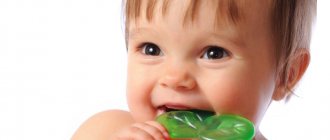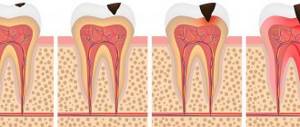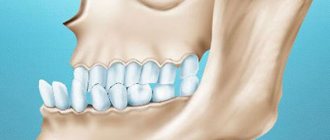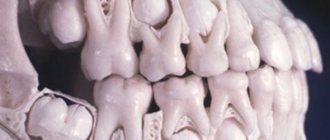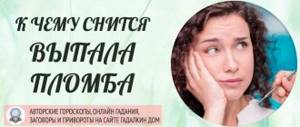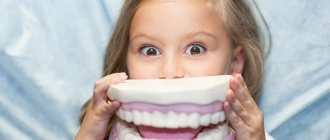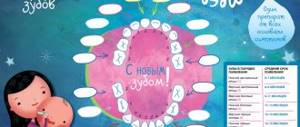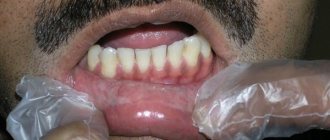30.11.2019
While the child is still small and does not understand why he needs to take care of the health of his teeth and oral cavity, this is one of the important tasks of his parents. Moreover, you need to pay attention not only to the condition of the teeth, but also to the health of the gums, because many diseases of the oral cavity begin with them.
Yellow, white or gray plaque, white or dark spots, and even ulcers may appear on the gums. Each of these symptoms has different causes and characteristics. Let's find out in more detail why a black spot may appear on a child's gum and how to cure such a pathology.
Causes of black spots on gums
If the baby is under three years old, there is a chance that the formation that has alerted you is an erupting tooth. Its appearance is accompanied by swelling and redness of the gums, sometimes it can darken significantly. You can gently touch the lump with your finger after washing your hands. When pressed, you feel that there is a hard formation under the relatively soft gum. This is a new tooth being felt.
It is believed that teething is a physiological process and does not require consultation with a dentist. However, if the gums are very swollen, have a bright red or bluish color, and the child reacts to manipulations in the mouth extremely painfully, this is a reason to consult a specialist.
Black spots on a child's gums may be evidence of a disease. With insufficient oral hygiene, weakened immunity, diseases accompanied by the consumption of medications that reduce the body's resistance, a pathological process may develop in the mouth, for example:
- gingivitis. This is a disease of the gums in which they become inflamed, swollen, and change color. There may be an unpleasant odor from the baby's mouth. Symptoms of gingivitis are unpleasant for a child - itching, burning sensation and soreness of the gums. Possible refusal to eat. The disease requires consultation with a doctor! He will prescribe treatment that is appropriate for the baby’s age and condition.
- stomatitis. The disease's symptoms are similar to gingivitis and also manifests itself as a white coating on the oral mucosa. It can be caused by either a fungus (“thrush”) or bacterial or viral agents. Precisely because there can be several causative agents of the disease, consultation with a pediatrician is mandatory - he will prescribe a medicine that will act specifically on the cause of the disease.
If a dark spot appears on the gum of an older child, one can also assume the traumatic nature of the formation. Ask him if he hit his face on something, perhaps got into a fight with someone, causing a “bruise” on his gum.
Etiology of the common cold
From a medical point of view, a cold should be called directly only the cooling of the body, which led to one of the probable diseases, but in colloquial speech a number of diseases are called a cold. And although they all have a different nature of occurrence, based on such a provocative factor as hypothermia, they are usually combined into a common group:
- rhinitis;
- ARVI;
- pharyngitis (nasopharyngitis);
- laryngitis.
All these diseases have a different clinical picture with some common symptoms, and although in some ways they may resemble the symptoms of a malaise in which the baby is teething, there should be no problems with how to distinguish one from the other.
How to treat a black spot on a child’s gum
If dark discoloration of the gums is a symptom of difficult tooth eruption, no specific treatment is required. It is necessary to observe. Milk teeth can take a long time to erupt, within 1-3 weeks. However, if the process is delayed, you should contact a specialist. You may need help from a dentist.
How are black spots on the gums treated if this symptom is not associated with the appearance of new teeth? First of all, it is necessary to establish the cause. So, if the gums are injured, the “bruise” will go away on its own. But it’s better to check the condition of your teeth. If the enamel of a tooth is cracked during an impact, caries will soon appear in this place. To prevent this from happening, you need to take measures in advance. Make an appointment with your dentist as soon as possible after discovering a dark spot.
Inflammatory processes in the gums are treated based on the cause of the disease. The doctor will definitely prescribe drug therapy to reduce unpleasant symptoms and influence the causative agents of the process. He will also recommend a diet, and perhaps prescribe general tonics.
Please note that a significant part of the inflammatory processes in the oral cavity is associated with insufficient oral hygiene. To prevent problems from occurring, teach your child how to take care of their teeth from early childhood. ASEPTA has developed a line of products specifically for children of different ages:
- BABY toothpaste and finger wipes for the little ones;
- KIDS pasta for children from 4 years old, which will appeal to even the most picky kids;
- TEENS product for children over 8 years old and teenagers. The excellent taste of the paste and prolonged protection will ensure healthy teeth and a snow-white smile.
ASEPTA takes care of children's teeth!
Sources:
- Study of the clinical effectiveness of the use of therapeutic and prophylactic agents of the ASEPTA series in the treatment of inflammatory periodontal diseases in children and adolescents (I.V. Klimova) Irina Vladimirovna Klimova, Candidate of Medical Sciences, Associate Professor of the Department of Pediatric Dentistry, Novosibirsk State Medical University. Department of Pediatric Dentistry, Novosibirsk State Medical University.
- The use of adhesive balm "Asepta®" in the treatment of inflammatory periodontal diseases L.Yu. OREKHOVA*, Dr. med. Sciences, Professor, Head of Department V.V. CHPP**, Dr. med. Sciences, Professor, Head of Department S.B. ULITOVSKY*, Dr. med. Sciences, Professor A.A. LEONTIEV*, dentist A.A. DOMORAD**, O.M. YAKOVLEV** SPbSMU named after. acad. I.P. Pavlova, St. Petersburg - *Department of Therapeutic Dentistry, **Department of Microbiology
- Clinical experience in using the Asepta series of products Fuchs Elena Ivanovna Assistant of the Department of Therapeutic and Pediatric Dentistry State Budgetary Educational Institution of Higher Professional Education Ryazan State Medical University named after Academician I.P. Pavlova of the Ministry of Health and Social Development of the Russian Federation (GBOU VPO RyazSMU Ministry of Health and Social Development of Russia)
Differences from rhinitis
There are more differences than similarities between rhinitis and the teething condition. In the acute course of this disease, the nasal mucosa becomes inflamed, which is accompanied by active sneezing, tearfulness and general malaise. When entering the chronic stage, rhinitis provokes, on the contrary, nasal congestion with obvious swelling, as well as regular mucopurulent discharge.
As can be seen from the above, none of these symptoms are characteristic of those that accompany teething. The only common feature is an increase in temperature, but this coincidence is clearly not enough to diagnose rhinitis in an infant. It should be added that this disease is a frequent companion to more severe diseases such as measles and scarlet fever.
The only common feature is an increase in temperature.
Important! Rhinitis, unlike teething, can cause headaches, but it is impossible to diagnose it in the case of infants without special equipment.
Differences from ARVI
ARVI (acute respiratory viral infection) is what doctors call inflammatory diseases caused by pneumotropic viruses. This list includes pathogens such as:
- influenza and parainfluenza;
- adenoviruses;
- rhinoviruses;
- respiratory syncytial virus;
- reoviruses;
- coronaviruses;
- herpes simplex;
- enteroviruses;
- mycoplasma;
- pathogenic bacteria.
In general, this is a very broad group of diseases, the most common of which in terms of colds are influenza and herpes simplex. The first of them cannot be confirmed without laboratory tests, since influenza in its symptoms is very similar to any other disease from the list of acute respiratory viral infections.
But even with mild forms of this disease, doctors note a sharp rise in body temperature to 38 - 40 degrees, which is completely different from teething. Moreover, the flu is accompanied by chills and weakness, as well as a dry and tense cough: a baby with cutting milk mucus cannot have all of this (except for a cough, but even that is not dry, but very wet, since the baby coughs up excess saliva).
Note! Only in people with strong immunity does the flu go smoothly within a few days, while in people at risk (including infants) it often provokes pulmonary or extrapulmonary complications. In severe forms of the disease, vascular collapse and cerebral edema are possible.
Even with mild forms of this disease, doctors note a sharp rise in body temperature to 38 - 40 degrees, which is completely different from teething.
As for herpes simplex, its distinctive feature is the appearance of characteristic blisters on the skin and mucous membranes. It is sometimes called a “cold on the lips” because of the visible symptoms, but this disease has little in common with the common cold. It is very difficult to confuse herpes with signs of teething.
Difference from laryngitis
Laryngitis in its clinical picture is very similar to pharyngitis, while the main difference between them is the localization of the inflammatory process. Laryngitis affects the larynx, not the mucous membrane of the pharynx. Otherwise, the symptoms are similar: dryness and sore throat, dry cough (which then changes its character due to phlegm), headache and a relatively low temperature - up to 37.5 degrees.
A distinctive feature of laryngitis is the appearance of hoarseness or hoarseness in the voice, up to its loss, which is directly related to inflammation of the larynx. Obviously, baby teeth cannot erupt with such a set of symptoms, so this disease can easily be crossed off the list of probable causes of a child’s illness.
Difference from pharyngitis
Pharyngitis can also act as a concomitant disease with ARVI, but being an independent disease, it is, first of all, an inflammation of the mucous membrane of the mouth and throat. In its acute form, this disease is characterized by a sore throat, pain and a dry, painful cough.
A child with pharyngitis may also suffer from a slight (low-grade) fever, but it is the presence of a cough against the background of obvious redness of the throat that makes it easy to distinguish such a disease from the symptoms that characterize erupting baby teeth.
The color of the first teeth, which should alert you
It is the color of the enamel of the first teeth that can indicate certain pathological processes occurring in the baby’s body:
- a blackish tint indicates excessive abuse of drugs and foods high in iron. Somewhat less often, such a shade may indicate a chronic process of inflammatory origin in the baby’s body.
- brownish tint of teeth, with yellowness - a mother who is breastfeeding her baby is abusing antibiotics, or the child herself is being stuffed with drugs from this group beyond measure.
- a yellowish tint of teeth, with a greenish coating , indicates blood diseases, and a reddish tint indicates a congenital disorder of metabolic processes, the production of a special pigment, porphyrin.
When a child's first teeth appear, they need to be looked after. Even the first, one tooth needs to be cleaned; you can use a clean bandage for mechanical cleaning or a special silicone attachment.
Gradually, you can get into the habit of using baby toothpaste and a brush with soft, natural bristles. They change it every month - until the child is 2 years old, parents brush the baby’s teeth, after which they accustom the child to the procedure. You should teach your child this hygiene procedure in the format of a game - a brush in the shape of a funny dinosaur and a toothpaste with a banana flavor will help with this.
Parents should regularly examine their baby’s oral cavity - this will help identify any dental problems at the very beginning and take timely measures to avoid serious complications.
When do babies start to have their first teeth?
Each baby’s body has individual characteristics, so it is impossible to say exactly how many months a particular child’s first tooth will erupt. Infants' first teeth appear between the ages of 3-4 months and 1 year. Teething during this period of time is normal. The following factors influence the timing of the appearance of the first teeth:
- Floor. Girls develop teeth earlier (the average age of appearance of the first baby tooth is 6 months) than boys.
- Climate. Children who permanently live in cool climates acquire teeth later than their peers from hot countries.
- Nutritional features. The more calcium enters the body, the higher the likelihood of early teething.
- Genetic features.
The first thing you can and should do for your child
How to relieve pain and alleviate the general condition of a child during teething without the use of medications?
The most common massage among people is considered to be gum massage; it doesn’t require much. Just a washed mother’s finger, which, with light pressure on the child’s inflamed gums, dulls the pain and reduces suffering, at least for a short time. Specialized silicone toothbrushes are also used for this “massage”.
Cold will also help relieve pain. Chilled teethers and food help relieve swelling from inflamed gums and reduce their soreness. As an option, you can use a cotton towel soaked in chamomile decoction. The dampened cloth must be placed in a plastic bag and cooled in the refrigerator. After which you can give the child to chew.
